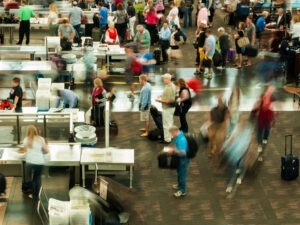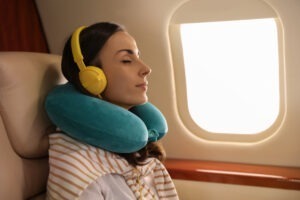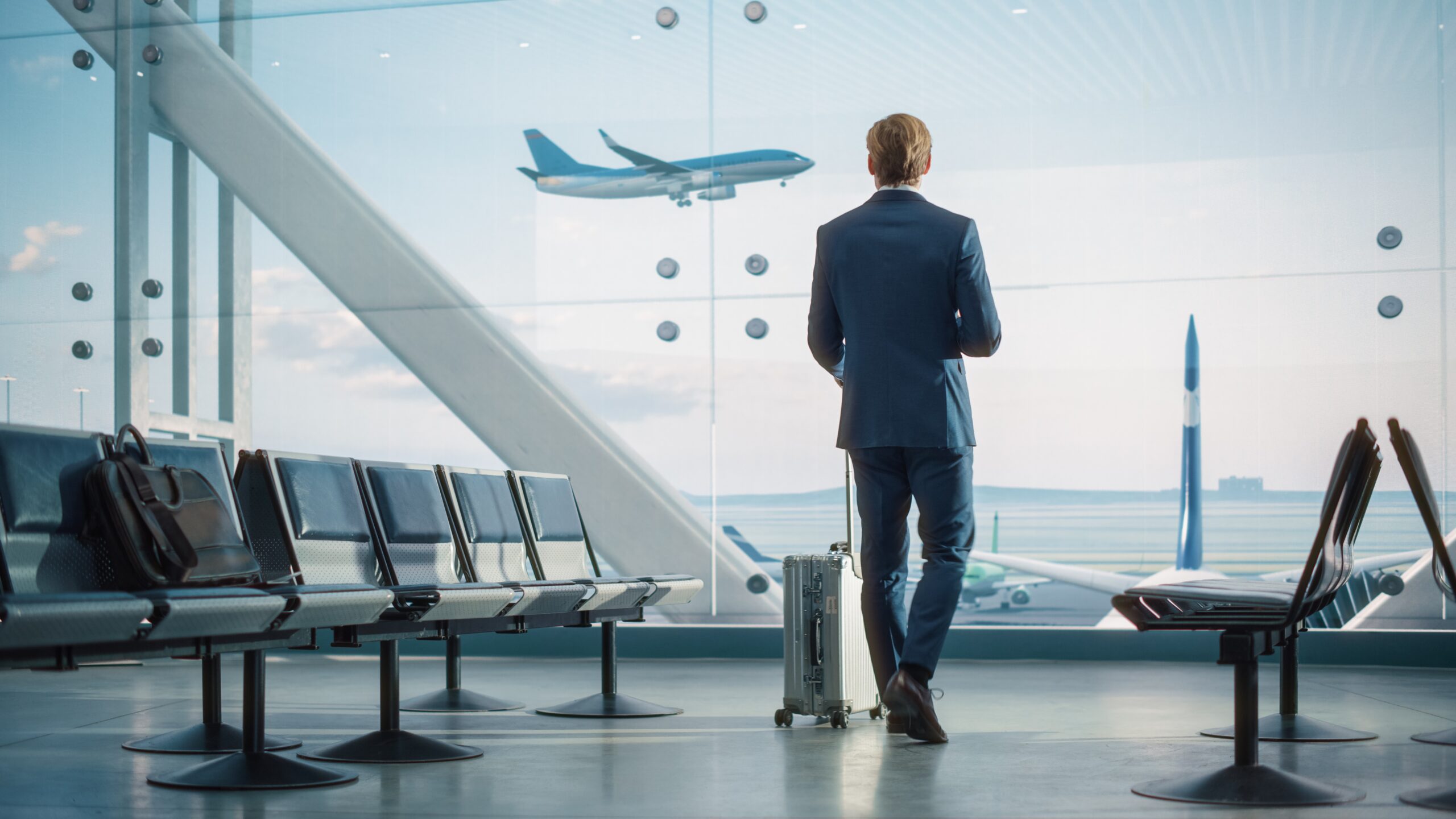Make Your Air Travel Easier Than Ever
Calling all those who travel for work!
We probably consider ourselves more well-versed in air travel than most. Our sealable travel bag of 3.4-ounce containers filled with face wash and lotion live tucked in our bathroom cabinets until, soon enough, they are packed once again into a suitcase and placed on the gleaming countertop of a hotel bathroom.
We breeze through security lines with our trusty carry-on suitcase. We know the perfect window of time to take off our shoes at the security checkpoint.
But that doesn’t mean airport journeys aren’t stressful, especially when we find ourselves stuck at the end of a long security line, frantically skimming the departures screen for our gate, or digging through our bag after getting through security to make sure we didn’t forget our vitamins or the shoes we had planned on wearing to dinner.
Read More: 11 Interesting Facts About Air Travel
The stress is amplified around the holidays, notoriously the busiest time of the year for air travel.
As people flock to the airport, frequent business travelers know that there’s always more room for tips and tricks to make the process easier. If you’re looking for ways to keep a cool head even in the busiest of airports or the longest red-eye flights, read on.
Suitcase with Strategy
Probably one of the worst feelings you can have in the airport is waiting for your bag to come through the scanner and thinking, “Oh, gosh, did I bring socks?”
I just recently found myself frantically digging through my bag after I’d gotten through the security checkpoint just to sigh in relief when I saw that I did, in fact, remember my prescription medication. Not fun.
Pack Early. Pack Again.
In order to make sure we remember every essential, it can be helpful to pack in advance—by that, I mean, far in advance. At least a week before your trip, pull out your luggage and pack all your clothing, your passport—basically everything that you know you want on your trip and won’t use in the week beforehand. Bonus points if you have a standard checklist to guide you.
If you’re a serial over-packer like me, a helpful addition is to go through your bag one or two nights before your departure. Do you really need five shirts for a three-day trip? Taking some time to distance yourself from what you’ve packed allows more insight into what’s most important and allows you fresh eyes to make sure you don’t forget an essential.
Read More: 9 Tricks for Packing Smarter
Work Some Method into the Madness
 Sometimes though, that suitcase still just won’t close. To free up extra space, don’t fold your clothes—roll them. It saves a surprising amount of suitcase real estate. And memorize the clothing formula: for most trips, bring a pair of socks and underwear for each day, five shirts, two pairs of pants, two pairs of shoes, one jacket and one outfit for a more upscale occasion, like a dress or suit. Then, build in your accessories, like scarves or belts. It’s even better if you repeat those accessories in different looks.
Sometimes though, that suitcase still just won’t close. To free up extra space, don’t fold your clothes—roll them. It saves a surprising amount of suitcase real estate. And memorize the clothing formula: for most trips, bring a pair of socks and underwear for each day, five shirts, two pairs of pants, two pairs of shoes, one jacket and one outfit for a more upscale occasion, like a dress or suit. Then, build in your accessories, like scarves or belts. It’s even better if you repeat those accessories in different looks.
Of course, this rule is subject to change based on the weather of your destination and the activities you have planned, but for the most part, it’s a great jumping-off point for packing. Neutral clothing is easier to mix and match, so you can create multiple looks out of the same items—and remember that many hotels offer laundry services. Be sure to take a look at the event agenda while you pack to make sure you aren’t forgetting about any themed activities you’ll want to dress up for.
Side note: I always pack a swimsuit. Yes, even in the winter. You never know.
Finally, make sure to pack your bulkiest clothing, like jackets and pants, in the bottom of your suitcase. This helps both in terms of weight distribution and leaves the items you’ll use more often, like shirts, more accessible.
Master the Time Zone
Business travelers are no strangers to regularly moving through time zones. Still, it’s always helpful to know how this really affects your body and how you can alleviate negative side effects.
Jet lag can cause you to struggle to fall asleep, yet feel drowsy during the day. It can be a source of headaches, stomach upset and mood changes, such as increased irritability. This certainly isn’t helpful when you have meetings to run or attend.
One golden rule of avoiding extreme jet lag symptoms is to start adjusting to your destination’s time zone as soon as possible—not only in terms of sleep but also in terms of mealtimes. For example, if your flight takes off at your breakfast time, but your destination’s lunch time is an hour into your flight, it’s helpful to have a very light breakfast and then a full lunch on the plane at your destination’s lunch time. When you arrive, do your best to wait until 10:00 p.m. at your destination to go to sleep—even if it’s 1:00 a.m. to your body. This works wonders to alter your body’s circadian rhythm quickly.
And of course, before your flight, avoid alcohol and caffeine. Both interfere with your body’s natural sleep cycles and make it more difficult to alter your sleep schedule. One of the most beneficial things you can do is drink water—lots of it. Staying hydrated means feeling more energized and being dehydrated can exacerbate those nasty jet lag side effects like headaches.
Read More: Secrets for Beating Jet Lag
Get Through Security Like a Pro
 There’s not much we can do about long security lines, but there are ways to prepare so you get through them as quickly and easily as possible. Firstly, it’s helpful to have a photo of your paper boarding pass, in case you lose it, or to download your digital boarding pass, in case you lose cell service. Downloading your airline’s app and signing up for alerts means you are the first to know about any last-minute gate changes or delays.
There’s not much we can do about long security lines, but there are ways to prepare so you get through them as quickly and easily as possible. Firstly, it’s helpful to have a photo of your paper boarding pass, in case you lose it, or to download your digital boarding pass, in case you lose cell service. Downloading your airline’s app and signing up for alerts means you are the first to know about any last-minute gate changes or delays.
According to Federal Aviation Administration (FAA) rules, passengers are allowed one carry-on suitcase and one personal item. Consider what you’ll have to remove when you put your bag through the scanner: electronics and liquids. Pack these items at the very top of your personal item rather than in your carry-on suitcase. This way, you won’t have to hold up the line unzipping your suitcase or searching through your bag. Once you’re through security, you can re-pack these items in the places you want to keep them for the rest of your travels.
Read More: Breeze Through Airport Security—Without the Perks
Finally, take a moment out of all that time you just saved to make eye contact with and thank the TSA officer at the security checkpoint. They are working hard in a fairly chaotic environment all day, and people don’t often acknowledge their presence as they rush to get through security. By recognizing their work, you might just make someone’s day.
Invest in a seriously decadent neck pillow (and that’s not all)
You’ve made it onto your plane—phew! Now that you’re nestled in your seat, it’s time to get set for a comfortable flight so you arrive at your destination with ease.
Care for Your Body
It’s helpful to bring a reusable water bottle that you fill up in the terminal before you board, so you aren’t relying on beverage service to stay hydrated. The Aerospace Medical Association (ASMA) suggests drinking around eight ounces of water for every hour we’re in the air to ensure we stay as hydrated on our flight as we would on a regular day. As stated earlier, when you’re dehydrated, you’re more likely to feel tired or irritable, experience headaches or suffer from jet lag.
To reduce muscle stiffness upon arrival, it does wonders to stretch occasionally. Every hour or so, do some small stretches that won’t get in the way of passengers next to you, such as mindfully rolling your head side-to-side to stretch your neck. Lean down so your chest meets the tops of your thighs to stretch your back. Flex your calves occasionally to restore blood flow that slows when you’re sitting for long periods of time.
Read More: 4 Ways to Make Air Travel More Comfortable
Prepare, Prepare and Prepare Some More
To maximize your comfort, be aware of the environment of an airplane cabin. The World Health Organization reports that cabin air humidity is usually less than 20%, when, according to the Environmental Protection Agency, normal indoor humidity should range between 30-50%. It’s always nice to have hand lotion and lip balm on hand. If you wear contacts, it’s often easier on your eyes to wear glasses during your flight instead.
 To be extra prepared, put together a plane kit for yourself. Any personal amenities you might need on a flight, like lotion, lip balm, a nail file, sound-canceling ear plugs or headphones (and even more specialized items like a neck pillow or compression socks) can make your flight infinitely more comfortable. It’s nice to have cough drops too, if dry cabin air makes you cough. It’s never fun to be the person with a coughing fit on the quiet plane.
To be extra prepared, put together a plane kit for yourself. Any personal amenities you might need on a flight, like lotion, lip balm, a nail file, sound-canceling ear plugs or headphones (and even more specialized items like a neck pillow or compression socks) can make your flight infinitely more comfortable. It’s nice to have cough drops too, if dry cabin air makes you cough. It’s never fun to be the person with a coughing fit on the quiet plane.
You can assemble a kit for yourself and keep it in your carry-on bag even when you aren’t traveling so you always have it with you when it’s time to get set for another flight.
And though many airlines offer a long list of movies and music nowadays, if you want to be certain you’ll be able to watch the next episode of your favorite show, your future self will thank you if you have it downloaded to your device before your flight. (P.S., make sure to charge all your devices to full battery the night before).
Back to the Basics
Even with extensive preparation, we still don’t have much control over surprisingly long security lines or flight delays. Still, by being prepared for what we can, the whole process of air travel becomes much more bearable.
Some final tips: Always, always make sure to check in to your flight as soon as the airline allows you to make sure you get the best seat, whether you’re adamant about the extra leg room of the aisle or love the views from the window. Set an alarm on your phone to remind you when it’s time to check in so you don’t forget. If you fly with an airline frequently, make an account to make sure your loyalty number and TSA Pre-Check numbers, if you have them, are already inputted correctly so you can speed up the check-in process.
Also, did you know that you don’t actually have to place your carry-on suitcase in the luggage compartment directly above your seat? (I was well into my adulthood before I figured that one out). If the overhead compartments already look very full, place your luggage in any compartment ahead of your seat. This can massively help to speed up de-planing so you aren’t holding up the crowd behind you when you get up from your seat.
While we’re talking about de-planing, it sure seems to take much longer than boarding. One thing you can do to help shorten this process is to avoid standing up before the people in the row in front of you start moving out of their seats. Operating in a line and taking turns makes the process much smoother and quicker (and the folks behind you will be grateful).
When it’s time to move from the airport to the hotel, it saves a lot of stress to make sure you’ve researched ground transportation options beforehand, like shuttles, taxis or ride-shares—especially if you’re in a location where you don’t speak the common language, or you’re simply tired.
Read More: Annoying Air Travelers and How to Not Become One
Next time you gear up for air travel, especially during the busier times of year, keep these tips in the back of your mind for a more seamless air travel experience.




